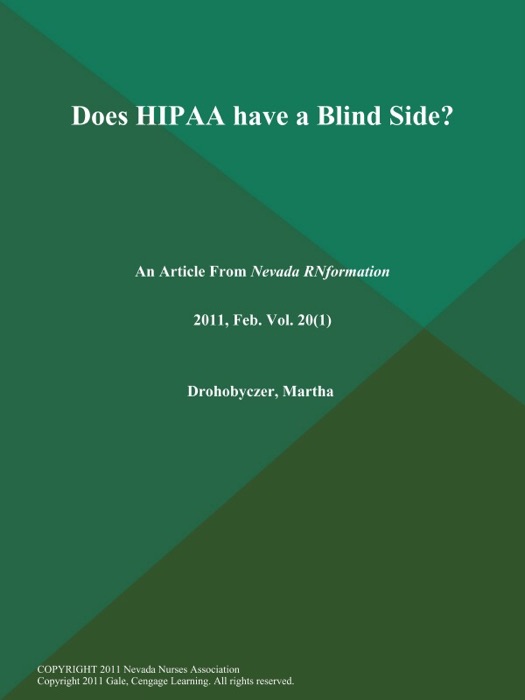(Download) "Does HIPAA have a Blind Side?" by Martha Drohobyczer # eBook PDF Kindle ePub Free

eBook details
- Title: Does HIPAA have a Blind Side?
- Author : Martha Drohobyczer
- Release Date : January 01, 2011
- Genre: Health & Fitness,Books,Health, Mind & Body,Business & Personal Finance,Industries & Professions,
- Pages : * pages
- Size : 46 KB
Description
The purpose of this article is to get health care professionals to think about how HIPAA regulations are preserved within their health care settings. Currently, many areas of hospitals, clinics and out patient services have what I call 'dead zones.' That is, an area where HIPAA regulations are not observed. The Health Insurance Portability and Accountability Act (HIPAA) (P.L.104-191) was enacted by the United States Congress in 1996. HIPAA has two titles. Title I was enacted to protect health insurance coverage for employees and their families, also known as Cobra or the Consolidated Omnibus Budget Reconciliation Act of 1985. Title II of HIPAA covers issues regarding the privacy of protected patient information, the development of national identifiers for providers and standards for electronic medical records. The regulations also spell out covered entities other than individual providers, hospitals, clinics and offices. The HIPAA Title II regulates how patient information may be transferred to other entities, how patients may obtain copies of their health records and when information may be shared with other entities without the necessity of having the patient sign a release. Examples would be if a mandated professional reports child or elder abuse, in particular emergency situations and if reports are sent to a referral source. Over the past few years I have noticed that there are areas in health care settings where HIPAA regulations are abandoned. I will call them HIPAA 'dead zones.' That is, areas where HIPAA regulations are dropped, similar to areas in a building where cell phone services are 'dropped.' In these areas the principles of privacy and the minimal exchange of protected information should be respected but is not. I will give examples of these areas and the protected patient information that may be overheard. The first area is labor and delivery triage. In most triage rooms multiple patients are in one room and the beds are usually separated by a curtain of some sort. Often in addition to the patient, a partner or relative maybe near the patient's bed. Nurses question patients about their most private information. It is common to hear questions such as 'when was your last menstrual period'? Questions regarding vaginal infection/discharge, bleeding, the last time the patient was intimate and drug or alcohol use/abuse are asked and responses may be heard by other patients. Health care providers that do not have a 'need to know' may also hear responses. The results of cervical examinations such as cervical dilation, fetal health status, urine dipstick results, and whether the patient has ruptured membranes are also heard. The phone call to a provider may be overheard that includes a report on the patient's condition. Worse yet is when various people may walk into the wrong room and are able to view the most private parts of a woman's body while she is giving birth. Once, two women were standing watching one of my patients give birth. I asked the patient if it was her mom and sister. She shrugged no and that she did not know them. They simply wanted to observe a birth.
Post a Comment for "(Download) "Does HIPAA have a Blind Side?" by Martha Drohobyczer # eBook PDF Kindle ePub Free"